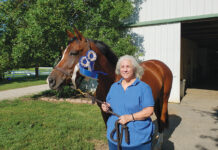
As the days heat up and the lush spring grass dies down, many horse owners find themselves faced with a quandary—how to get their pastures in good shape to provide their horses with nutritious grass into the fall. Healthy pasture is good for horses mentally and physically, as it mimics their natural feeding pattern, and it saves owners money spent on ever-increasing hay prices.
Of course, not every horse owner has thousands of acres to work with like some of the idyllic showpiece farms you might drive past in the heart of horse country. What can be done to help limited spaces?
“Boarding farms and other small farms with two to three horses on around 10 acres really face an overgrazing problem,” says Keene. “The best thing you can do to deal with that is to rotate: Let the horses graze down the pasture and then move them to another field. Many farms keep horses on the same pastures 365 days a year, but you should get them off the fields for a significant amount of time to let the grass recover.”
Even if you do not have enough properly fenced areas to rotate pastures, there is still hope. “Electric fencing and portable waterers can be used to subdivide fields, and are not utilized nearly enough. It’s not an easy problem to overcome—it takes a strong commitment to improving pastures.” If you are worried about the investment required to give fields time off, Keene has this advice to offer: “The cheapest way to feed a horse is with pasture, so it’s not only good for the grass [to give it time to grow], it’s economically smart, too.”
Many horse owners battle weeds that take over space from grass, but it’s hard to know the best way to handle them. “More often than not, you’ll have to spray a chemical herbicide,” Keene advises. This should be done when horses are rotated off the field. “Work with a county extension agent or farm supply store to decide which type of weed control is best for your situation.” Herbicide should be applied in late April or early May, after ragweed has had a chance to germinate. Growing weeds can be sprayed again in late September or early October. According to Keene, “The best form of weed control is a thick stand of grass. When weed seeds germinate in the soil, the grass will block light from getting to them, and they’ll perish.”
Starting Over
If pastures are so badly damaged that the only solution is to start from scratch with seed—with or without fully killing off the pasture first—Keene recommends seeding in late summer or early fall.
“The best way to seed is to use a slit-seeder in two different directions for the seed-soil contact that is so critical. The next best method is to chain harrow and then [mechanically] broadcast seed, followed by a light coating of compost or straw,” says Keene.
The most important thing to keep in mind if re-seeding is that horses should be kept off the pasture to avoid wasting your effort. “Young seedlings are killed by hoof traffic, so put up an electric fence if you have to,” says Keene. “The seeds will germinate in the fall, getting 2 to 4 inches tall. Still, don’t put horses out there until late May or early June of the following year, when the turf has knit together and can support traffic.” This is close to a nine-month investment, but it will be worthwhile when the ground starts to dry up in the summer and the roots are able to fully establish a nutritious pasture.
When it comes to a lush, healthy pasture for your horse, the bottom line is hard work. Seeding, weed management and rotational grazing don’t happen on their own, so start early if you want to create a plan to rehabilitate your pastures this summer.
For more information, visit www.uky.edu/Ag/Forage.
This article originally appeared in the June 2009 issue of Horse Illustrated. Click here to subscribe.






